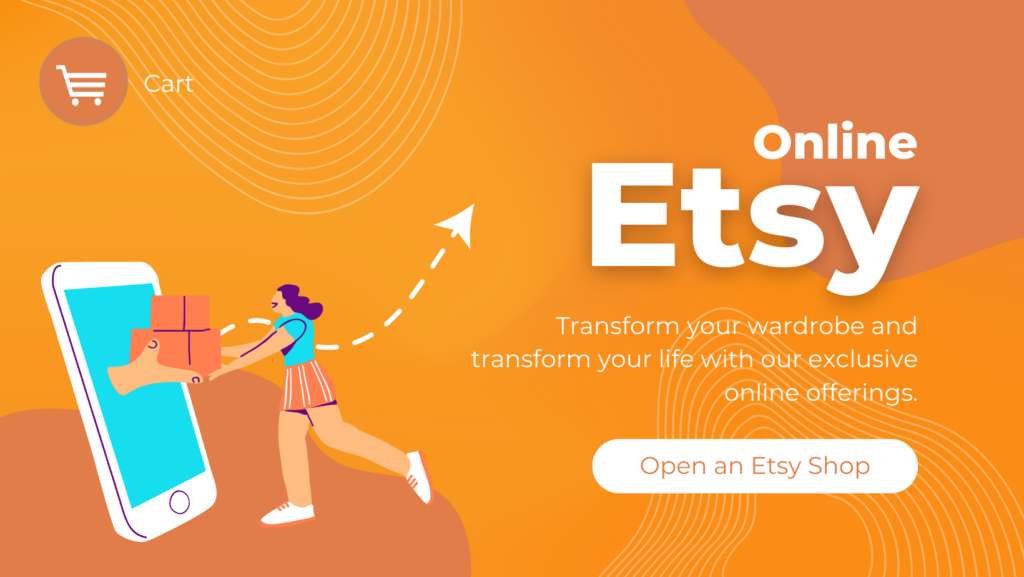Fast & Easy Steps to Open an Etsy Shop
Fast & Easy Steps to Open an Etsy Shop

Getting Started with Your Etsy Shop
Are you interested in starting your own Etsy shop? Whether you're a craft enthusiast or a small business owner, this beginner's guide to Etsy will set you on the path to success. Opening an Etsy shop is a great way to showcase your creativity and sell your unique products to a global audience.
To start your journey, follow these simple steps:
- Research and Planning: Before diving into opening an Etsy shop, take some time to research and plan. Explore different product categories on Etsy and identify what interests you the most. Consider your skills, passions, and hobbies when choosing the right product to sell.
- Sign Up for an Etsy Account: To get started, sign up for an Etsy account by visiting their website. Click on the "Sell on Etsy" button and follow the prompts to create your account.
- Set Up Your Shop Preferences: Once you've created an account, it's time to set up your shop preferences. Choose a name that reflects your brand or products and create a compelling logo that represents your style. Customize your shop's appearance and layout to make it visually appealing.
- Define Your Shop Policies: Establish clear policies regarding shipping, returns, and customer service. This will help build trust with potential buyers and ensure smooth transactions.
- Listing Your First Product: Now comes the exciting part – listing your first product! Take high-quality photos of your item from different angles and write engaging product descriptions that highlight its features and benefits. Use persuasive language to entice potential buyers.
Remember, starting an Etsy shop is just the beginning of your entrepreneurial journey. Stay tuned for more tips on how to effectively market and promote your shop in later sections of this blog post.
Choosing the Right Product to Sell
When starting an Etsy shop, choosing the right product to sell is crucial for your success. Here are some steps to help you make an informed decision:
Researching Market Trends
Begin by identifying popular product categories on Etsy. Browse through different sections and take note of items that have high sales and positive customer reviews. This will give you an idea of what products are in demand.
Next, analyze the market demand and competition for your chosen product. Use tools like Google Trends or Etsy's own search bar to see if there is a consistent interest in your product over time. Additionally, explore other online marketplaces or social media platforms to gauge the competition and identify any gaps in the market.
Finding Your Niche
To stand out from the competition, it's important to find your niche within your chosen product category. Start by exploring your interests, skills, and unique selling points. Consider what sets you apart from other sellers and how you can offer something different or better.
Take into account target audience preferences when narrowing down your niche. Who is your ideal customer? What do they value? Understanding their needs and preferences will help you tailor your products to meet their expectations.
Additionally, look for untapped market opportunities within your chosen niche. Is there a specific style or theme that hasn't been fully explored? Can you offer a unique twist or customization options? Identifying these opportunities will give you a competitive edge and attract customers looking for something new.
Remember, finding the right product takes time and research. Don't rush this process as it lays the foundation for a successful Etsy shop.
Setting Up Your Etsy Shop
Now that you've chosen the right product to sell, it's time to set up your Etsy shop. Follow these steps to get started:
Creating an Etsy Account
The first step is to sign up for an Etsy account. Visit the Etsy website and click on the "Sell on Etsy" button. Follow the prompts to create your account by providing your email address, choosing a password, and agreeing to the terms of use.
Once you've created an account, it's time to set up your shop preferences and policies. This includes selecting your preferred language, currency, and location. Take some time to carefully read and understand Etsy's seller policies regarding fees, shipping, returns, and customer service.
Designing Your Shop
Designing your shop is an important aspect of creating a strong brand identity on Etsy. Start by choosing a shop name that reflects your brand or products. Make sure it's memorable and easy to spell.
Next, create a compelling logo that represents your style or niche. You can design one yourself using graphic design tools like Canva or hire a professional designer if you have the budget.
Customize your shop's appearance and layout by selecting a visually appealing banner image that showcases your products or brand aesthetic. Choose colors that align with your branding and make sure the overall look is cohesive.
Consider adding sections within your shop to organize different types of products or collections. This will make it easier for customers to navigate through your offerings.
Effective Product Listing
When it comes to selling on Etsy, creating effective product listings is essential for attracting potential buyers. Follow these tips to optimize your product listings and increase your chances of making sales:
Writing Engaging Product Descriptions
To capture the attention of potential buyers, it's important to write engaging product descriptions. Highlight the key features and benefits of your products in a clear and concise manner. Use descriptive language that paints a vivid picture in the customer's mind.
Consider using storytelling techniques to create an emotional connection with your audience. Share the inspiration behind your products or any unique stories associated with them. This helps create a sense of authenticity and adds value to your offerings.
Remember to include important details such as dimensions, materials used, and any special care instructions. Be honest and transparent about what customers can expect from their purchase.
Optimizing Product Titles and Tags
Optimizing your product titles and tags is crucial for improving search visibility on Etsy. Include relevant keywords in both the title and tags section of your listing.
When crafting your titles, use descriptive and specific terms that accurately represent your product. Think about what potential buyers might search for when looking for items like yours. For example, instead of simply saying "Handmade Necklace," you could use "Bohemian Style Handmade Necklace with Natural Gemstones."
Incorporate relevant keywords into your tags as well. These are additional words or phrases that describe your product but may not be included in the title or description. Use variations of keywords, synonyms, or related terms to broaden the reach of your listings.
Remember not to overstuff keywords in an unnatural way. Focus on creating informative and readable titles and tags that accurately represent your products.
Promoting Your Etsy Shop
Once you've set up your Etsy shop and listed your products, it's time to focus on promoting your shop to drive traffic and increase sales. Here are two effective strategies for promoting your Etsy shop:
Utilizing Social Media
Creating social media accounts dedicated to your Etsy shop can significantly boost your visibility and reach a wider audience. Choose platforms that align with your target market, such as Instagram, Facebook, or Pinterest.
Share product updates, behind-the-scenes content, and engaging posts that showcase the unique aspects of your products. Use high-quality images and compelling captions to capture the attention of potential customers. Encourage followers to visit your Etsy shop by including direct links in your social media profiles or posts.
Engage with your audience by responding to comments, messages, and inquiries promptly. Building a genuine connection with potential buyers can help establish trust and loyalty.
Consider running targeted ads on social media platforms to reach a larger audience. Experiment with different ad formats such as photo ads, video ads, or carousel ads to see what resonates best with your target market.
Collaborating with Influencers
Influencer marketing is another powerful way to promote your Etsy shop. Identify relevant influencers in your niche who have a significant following and engage with an audience interested in products like yours.
Reach out to these influencers for collaborations, sponsored posts, or product reviews. Offer them free samples of your products in exchange for their honest feedback or promotion on their social media channels or blogs.
When collaborating with influencers, ensure that their values align with yours and that they have an engaged and authentic following. This will help maximize the impact of their promotion on driving traffic to your Etsy store.
Remember to track the performance of each promotional effort using analytics tools provided by social media platforms. This will help you identify which strategies are most effective in driving traffic and sales for your Etsy shop.
Valuable Tips for Etsy Success
To ensure the success of your Etsy shop, it's important to focus on providing excellent customer service and consistently monitoring and analyzing your shop's performance. Here are some valuable tips to help you achieve Etsy success:
Offering Excellent Customer Service
Respond promptly to customer inquiries and messages. Aim to provide helpful and friendly responses that address any questions or concerns they may have. Timely communication shows that you value your customers and their satisfaction.
Provide accurate product information and shipping details. Clearly state important details such as dimensions, materials used, processing times, and estimated delivery dates. This helps manage customer expectations and reduces the likelihood of misunderstandings or disputes.
Consider going the extra mile by including a personalized note or small thank-you gift with each order. This thoughtful gesture can leave a lasting impression on your customers and encourage them to leave positive reviews or recommend your shop to others.
Monitoring and Analyzing Shop Performance
Regularly track sales, customer reviews, and shop statistics provided by Etsy's analytics tools. Pay attention to trends in sales volume, popular products, and customer feedback. Identify areas where you can improve or expand your offerings based on this data.
Take note of any negative reviews or feedback from customers and use them as opportunities for improvement. Address any issues raised by customers promptly and professionally.
Experiment with different strategies such as pricing adjustments, product variations, or targeted promotions to see what works best for your shop. Continuously analyze the results of these efforts to optimize your Etsy shop's performance.
By actively monitoring and analyzing your shop's performance, you can make informed decisions that drive growth and success in the long run.
Key Takeaways for Opening an Etsy Shop
Starting your own Etsy shop can be an exciting and rewarding venture. Here are the key takeaways to remember as you embark on this journey:
- Follow the step-by-step guide: This blog has provided you with a comprehensive step-by-step guide on how to open an Etsy shop quickly and easily. By following these steps, you'll have a solid foundation for success.
- Choose the right product: Research market trends and find your niche. Identify popular product categories on Etsy, analyze market demand, and consider your unique selling points. Finding the right product is crucial for attracting customers and standing out from the competition.
- Effectively set up your Etsy shop: Create an Etsy account, set up your shop preferences and policies, and design your shop to reflect your brand. Pay attention to details like choosing a compelling shop name, creating a captivating logo, and customizing your shop's appearance.
- Optimize product listings: Write engaging product descriptions that highlight key features and benefits. Use persuasive language and storytelling techniques to captivate potential buyers. Optimize product titles and tags by including relevant keywords that improve search visibility.
- Promote your shop: Utilize social media platforms to create accounts dedicated to your Etsy shop. Share updates, behind-the-scenes content, engage with your audience, and consider collaborating with influencers in your niche.
By following these key takeaways, you'll be well on your way to opening a successful Etsy shop that attracts customers, generates sales, and brings fulfillment to both you as a seller and your customers as buyers.





